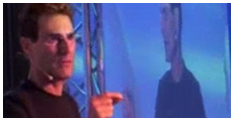TIME EUROPE
March 6, 2000 Vol. 155 No. 9
Cutting Edge Humanity
With the help of digital photography and the Internet, caring surgeons rebuild the face of a Kosovo war victim
By JONATHAN MARGOLIS Manchester
Thursday April 29 last year, a rainy day in Kosovo, should really have been the last of Besim Kadriu’s short life. That morning in the Albanian sector of the town of Mitrovica–a town once again torn apart by communal strife (see following story)–Serb paramilitaries torched the house the 21-year-old economics student shared with his pregnant wife, Valbona. Watching the inferno from a distance, Kadriu was confident Valbona had escaped Mitrovica, but was unsure where she had fled. He set off on foot for the village of Zaza, a few kilometers away, on a hunch she would be with her two brothers, who lived there. She wasn’t, but a large number of armed Serb militiamen were. They were closing in on Zaza just as he arrived. For the second time in a day, Kadriu was facing death.
Thugs in balaclavas surrounded the village in three concentric rings, moving inward to trap the inhabitants in much the same way that small game animals are sometimes hunted in the Balkans. Knowing they were prime targets, Kadriu and a few of the other young men in Zaza tried to escape. They managed to slip through the two innermost cordons undetected.
But as they attempted the third, they were spotted. One of Kadriu’s brothers-in-law was shot dead on the spot. Four  other men surrendered and were never seen again. Kadriu and the other brother-in-law made a run for the woods. The brother-in-law was shot in the leg but kept running and survived. Kadriu felt a bullet sting his face, fell to the ground and played dead.
other men surrendered and were never seen again. Kadriu and the other brother-in-law made a run for the woods. The brother-in-law was shot in the leg but kept running and survived. Kadriu felt a bullet sting his face, fell to the ground and played dead.
The Serbs may have believed they had killed him, or simply have thought it unnecessary to waste any more bullets on the young man. Much of the right side of the face of their previously handsome victim, including his entire nose and right eye, had been removed by the shot. What was left of him resembled a medieval gargoyle after centuries of erosion.
At nightfall, several hours after the Serbs had left, Kadriu ran to the forest and hid. Although he felt nauseated and could sense blood running down his face, there was no pain from the wound. He touched the destroyed area and, in his state of shock, thought the bony sensation was damaged teeth. He realized things were much worse only when he explored the inside of his mouth with his fingers and found it was intact.
A strong-minded, pragmatic man, Kadriu resolved immediately to avoid glimpsing any reflection of himself in puddles left by the rain, even though he needed them to drink from during the 48 hours he remained in the woods. For his psychological survival, this was probably a good tactic. So grotesque were his injuries that when he finally judged it safe to return to Zaza he went unrecognized. People scurried from him in horror until he produced a photo he happened to have in the back pocket of his jeans. It showed him and Valbona smiling for the camera a few months before, at Christmas 1998, days after they had married.
Besim Kadriu still keeps that photo in his wallet as a lucky charm, for while many people would opt for death rather than disfigurement, he considers himself a fortunate man. For one thing, a couple of centimeters further back and that Serb bullet would have hit his brain, destroying his mind as well as his looks. For another, he was reunited with Valbona and survived for three months in the care of relatives–without disinfectants or antibiotics, his only treatment being changes of gauze bandages, when they could be found. He was still avoiding mirrors when troops of the kfor peacekeeping force arrived to provide some less rudimentary first aid. But luckiest of all–and thanks to the efforts of an American charity doctor and a British military medic with a bag full of electronic gizmos and an Internet connection–Kadriu’s face has now been rebuilt by surgeons in Manchester, U.K.
Besim Kadriu thus became one of the first civilian beneficiaries of military telemedicine, the use of digital technology in treating war injuries beyond the scope of army field surgeons. Thanks in no small part to the Internet, he and Valbona are now living in Manchester awaiting the final cosmetic work on his face before resuming life in Kosovo. In the crib in their small apartment is their new daughter, born two days before Christmas.
Telemedicine is a variation on the tradition of referring difficult cases to a specialist–the difference being that the specialist doesn’t see the patient, only e-mailed photos of him. With a digital camera, a laptop and a gsm phone wielded by a doctor in the field, the specialist can be across the world, viewing high-definition photos of a wound inflicted perhaps only minutes earlier. It was such technology that made the link between an act of butchery in a meadow in Kosovo and one of medical mercy in a hospital in Manchester.
Before the technology, however, came philanthropy. In June 1999 Dan Clay, a California emergency room physician, set up a clinic in Kqiq, on the outskirts of Mitrovica, for the International Medical Corps, a charity based in Los Angeles. Kadriu soon heard about the new American clinic and, with his wound covered by a gauze pad, went to see “Dr. Dan.”
Like every doctor who was later to meet the young man, Clay was shocked by the wound. But he recognized that it was far beyond his expertise to treat. “When I first saw Besim across the room with a large bandage over his ‘eye,’ I assumed I would be seeing a corneal abrasion or the like,” says Clay, now back at the rural St. Helena Hospital in Deer Park, Calif. “But nothing could prepare a doctor for what lay beneath the gauze. I’ve spent half my career in ERs in some of the most violent cities in America, seen all kinds of mangled human beings, but I’ve never come across anyone still alive carrying such a horrific injury as Besim.”
“I sent him to the Pristina Hospital, knowing full well that what he needed was beyond the capabilities of its surgeons,” says Clay. “They, of course, returned him with a suggestion that he be referred for treatment abroad. Unfortunately the channels for such a placement are a bureaucratic obstacle course and were overwhelmed in any event.” Clay knew that the recommendation doomed a 21-year-old man to a life with a cruel disfigurement, but “I also knew that I had become his only hope, as I was not prepared to accept that unthinkable notion. So in June, I started face shopping, talking to every kfor medical officer and every mash unit I could find, hoping that one would know of a bored plastic surgeon somewhere, or perhaps get as emotionally involved in Besim’s case as I was.”
Clay soon found a committed colleague in Lieut. Colonel David Vassallo, a British army doctor who had days earlier set up the Royal Army Medical Corps’ 22 Field Hospital in a former Serb army base at Lipljan, outside Pristina. Maltese-born Vassallo was equally gripped by Kadriu’s plight. “He presented with a gaping hole in his face,” says Vassallo, now in Bosnia. “Looking at him made me think of a horror film. To sustain that kind of injury without dying and then to wander around untreated for three months, at risk of infection, was almost impossible to imagine.” Like Clay, Vassallo knew there was little he could do for Kadriu, but he’s an evangelist for telemedicine, and was eager to prove that a simplified, low-cost system he had been developing with colleagues in the U.K. could work for humanitarian purposes.
The first step in securing medical evacuation for refugees, Vassallo knew, was to get influential doctors abroad so involved in serious cases that they would put pressure on their governments. But he had been unable to arouse much interest from specialists abroad by merely describing cases in letters and e-mails. Vassallo concluded he needed not words but pictures.
Such imaging technology was already in use by the U.S. military, which had been pioneering video telemedicine with hardware costing millions of dollars and requiring a team of specialists to operate. But the equipment and software that Vassallo used–a couple of digital cameras loaned by Japanese camera maker Olympus and his own Toshiba laptop–cost only a few thousand dollars. A satellite phone bought by the British army and Vassallo’s account with America Online completed the package. “The principle followed throughout has been, ‘Keep it simple’ to ensure that the system can easily be used by doctors,” Vassallo says. “I damaged the Olympus we used in Bosnia but was able to buy a replacement [at the military duty-free store] that day. At the same time, the Americans had a whole container load of telemedicine equipment, but the technician was on leave for two weeks so they couldn’t use it.”
The uncomplicated British system worked. Minutes after Besim Kadriu walked into the hospital in Lipljan with Clay, Vassallo was photographing the Kosovar’s ruined face and e-mailing the digital pictures to colleagues at his base at Fareham, near Portsmouth in England. At their suggestion, he e-mailed the pictures to Richard Loukota, a maxillofacial reconstructive surgeon at Leeds General Infirmary in Yorkshire. For a little added emotional pull, Vassallo copied Kadriu’s wallet photo of himself and his wife before the shooting and added it to the e-mail.
Loukota was fascinated by the challenge of creating a face from such shattered remains. But he could tell by the photos from the other side of Europe that the lengthy series of operations Kadriu needed would require not only a world-class maxillofacial reconstructive consultant–a kind of superqualified dentist who rebuilds faces–but an ophthalmic surgeon to fashion something that looked like a right eye; an ear, nose and throat doctor to try to salvage what was left of his nose and build a new one around it; and an anesthetist able to keep the patient alive for the 12 hours or more at a stretch that these procedures could take. Moreover, all these professionals would have to be prepared to work on their day off, effectively as volunteers.
The photos from Kosovo were copied and recopied in e-mail from Loukota in Leeds to surgeons across Britain who had responded to a British Medical Journal article appealing for help from National Health Service surgeons for Kosovo victims. The complexities of coordinating surgeons’ timetables and the bureaucracy of funding the exercise–even if the doctors worked for nothing, regional health service accountants have to pay for public hospital facilities on a pseudocommercial basis–meant that plans for Kadriu’s operation began to coalesce around Manchester, where the necessary team of specialists could be assembled more swiftly, rather than Leeds.
After Loukota, the first to volunteer to work on Kadriu was Brian Leatherbarrow, an ophthalmologist and oculoplastic surgeon specializing in artificial eyes at the Manchester Royal Eye Hospital. Leather-barrow downloaded the images from Kosovo to his computer at home in Alderley Edge, a suburb of Manchester. “It was a very good quality image of Besim, and I printed it off and took it to the hospital, where because of stupid technical difficulties within the nhs, my computer is not linked up to the Internet,” Leatherbarrow explains. “Apart from being sent the occasional photo in the post, Besim was the only patient whose deformity I have ever seen ahead of time. I can see how it would help enormously as a more common practice.”
Soon after, a maxillofacial surgeon at North Manchester General Hospital, Bob Woodwards, joined the team along with ear, nose and throat consultant Prad Murphy and anesthetist Harry Vallance. “My emotional reaction when I first saw Besim was, what a tragedy this is to happen to such a nice young man,” says Woodwards. “But his personality shined through all the disfigurement. And for people who practice reconstructive surgery, there’s no doubt it was a challenge, a thrill really, thinking to yourself, how can we get this chap into a reasonable state?”
As the doctors were organizing their team, even the bureaucrats searching for a way to make it work were showing the kind of energy people of goodwill can muster for a good cause. The civil servants came up with a formula based on a reciprocal health care arrangement between Yugoslavia and the U.K. that had been concluded long before the war. When a British subject fell ill in Yugoslavia, he would be treated free, and vice versa. The officials declared that Kosovo was still part of Yugoslavia and the r.a.m.c. 22 Field Hospital in Lipljan was temporarily British sovereign territory, so Kadriu could be regarded as a case of a Yugoslav citizen who had fallen ill in Britain. Hospital bills would therefore be picked up by the central government rather than the local nhs, and people in Manchester would have no cause to complain that their health care was suffering because of the treatment given to Kosovo refugees.
It was a useful bureaucratic formula: after Kadriu’s subsequent transfer to the U.K. by the R.A.F., the British Home Office used the same logic to bring a further 50 seriously wounded Kosovars for treatment in the U.K. Several of the patients were treated by Richard Loukota–who became so involved in those cases that in the end he was unable to take part in Kadriu’s operation.
That operation was finally performed in December–a week before Kadriu’s daughter was born–at the sprawling North Manchester General Hospital. It took 15 hours and involved details that sound more like makeshift engineering than surgery. First, Leatherbarrow removed the remains of Kadriu’s damaged eye and retrieved its surrounding membrane, which he filled with a piece of fat from Kadriu’s hip to create an eye-shaped blob with the remaining ocular muscles attached to it. It will later form a mobile platform for a false eye resembling a giant contact lens. With the machinery for the artificial eye in place, Leatherbarrow then recreated a right upper eyelid using cartilage grafted from the back of an ear and a lower eyelid with skin from the forehead.
Woodwards then took over, exposed the remaining bony parts of the patient’s cheek area and screwed in a set of precision titanium plates made to his specifications by a team at University College, London. The missing mid-face soft tissue and skin were replaced with a graft from Kadriu’s left forearm, complete with its own artery, which Woodwards stitched into the jugular vein and facial artery, working at times with a microscope to join blood vessels as thin as half a millimeter in diameter. The resulting gap in Kadriu’s arm was filled with flesh from his groin.
Murphy, the ear, nose and throat surgeon, then fitted a titanium nasal bone and fabricated a new nose around it from part of the flap from the arm. Fortunately, the nasal passages and linings were still present in residual form, and worked normally after the operation. There was not quite enough spare flesh to give Kadriu his original Roman nose; he now has something shorter and more north-European looking.
The successful operation left a delighted Kadriu looking something like himself again, albeit with a pale flap across his face. Woodwards promises this skin from his underarm will in time become tanned and match the rest of his face–although with Manchester famed for its rain, he will need makeup for a while. Kadriu’s face is still swollen and dressed, but the prognosis is that by summer, with his new eye fitted, he will look and feel well enough to go back to Mitrovica.
For the moment, living in an apartment block in Manchester occupied entirely by Kosovar re-fugees, Kadriu seems a happy man. Valbona tends the baby, swaddling her in Albanian style, and has a support network of other young ethnic Albanian women around her. She is still mourning her brother, who was killed on the escape run with Besim back in Zaza, but nonetheless longs to return to Kosovo.
It is clearly not easy for Kadriu to relate the details of his shooting through an Albanian interpreter, but he is measured and phlegmatic. Emotional reaction overcomes him only at certain moments. When taking a wedding photo from its frame to show visitors, a key falls out from behind the print. “This is key to house in Kosovo,” he says tearfully in his newly acquired English. “Now the key is all we have. House gone.”
Digital pictures of Besim Kadriu as he recovers continue to flash across the Internet, keeping the band of doctors following his case informed of his progress. A few days after Kadriu’s operation David Vassallo, in England on leave, went straight to Manchester, digital camera in hand, to visit Kadriu. The photos were on the Internet by evening.
In California, Dan Clay was especially thrilled to see them. “He looks beautiful,” he said. “I think I will always rate downloading those photos from Manchester as one of the greatest moments of my medical career.”
Pictures are said to be worth a thousand words, but in this case their value has been far greater. They have proved to be worth a new face–and a new life–for a young man who was left for dead on a lonely field in Kosovo.
CLick here to read this article on the Time website


Latest Articles

Motivational Inspirational Speaker
Motivational, inspirational, empowering compelling 'infotainment' which leaves the audience amazed, mesmerized, motivated, enthusiastic, revitalised and with a much improved positive mental attitude, state of mind & self-belief.



















